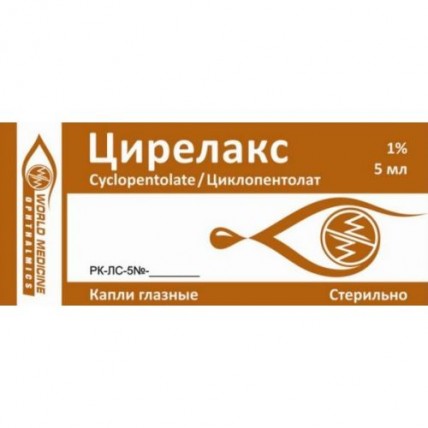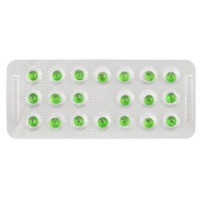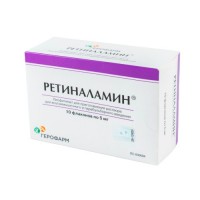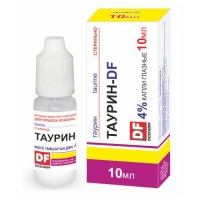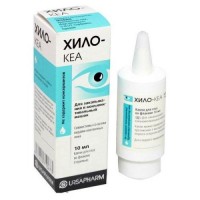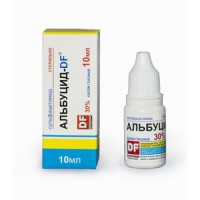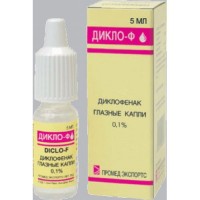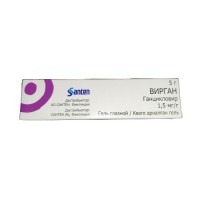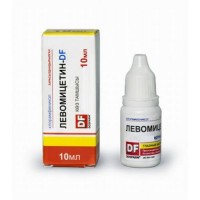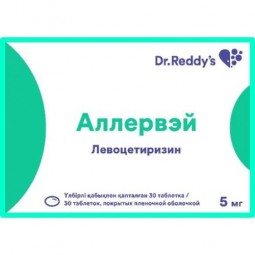The instruction for medical use of Tsirelaks Torgovoye medicine a name of Tsirelaks the International unlicensed name Tsiklopentolat Lekarstvennaya the Drop form eye, 1% Structure of 1 ml of drug contains active agent - the tsiklopentolat a hydrochloride of 10 mg, excipients: a benzalkoniya chloride, boric acid, dinatrium edetat, potassium chloride, sodium carbonate/acid chlorohydrogen, the water purified. The description Transparent colourless solution Pharmacotherapeutic group Drugs for treatment of diseases of sense bodys. Drugs for treatment of diseases of eyes. Midriatiki. Holinoblokatora. Tsiklopentolat. The ATX S01FA04 code the Pharmacological Tsiklopentolat Pharmacodynamics properties is well soaked up through a conjunctiva. Concentration in the central nervous system is reached in 0.5-1 hour. Linking with proteins of blood plasma moderate. Elimination half-life (Т½) makes 2 hours. Mydriasis (mydriasis) comes within 25-75 minutes after single burying. The mydriasis remains within 6-12 hours, at especially sensitive patients the easy mydriasis can remain much longer. The residual phenomena of a tsikloplegiya remain within 12-24 hours. The pharmacokinetics of Tsirelaks as active agent contains the tsiklopentolat the hydrochloride which is tertiary synthetic amine similar in action to atropine. Blocks m-holinoretseptory, interferes with action of a mediator of cholinergic synapses – acetylcholine. As a result of blocking of the m-holinoretseptorov located in a sphincter of a pupil and in a tsiliarny muscle there is a mydriasis due to prevalence of a tone of a muscle, the expanding pupil, and relaxations of the muscle narrowing a pupil. At the same time due to relaxation of a tsiliarny muscle there is paralysis of accommodation (tsikloplegiya). At systemic action reduces secretion salivary, gastric, bronchial, sweat glands, a pancreas, reduces a tone of muscles of a GIT, bile ducts and a gall bladder, causes tachycardia, the conductivity improves AV. Excites a cerebral cortex in high doses. Works quickly, but it is less long, than atropine. The maximum effect develops in 75 min. after instillation. Complete recovery of accommodation usually happens in 6-24 h, in individual cases - in several days. Indications - for calling of a mydriasis and accommodation by ophthalmologic inspection the Route of administration and doses Adult, including elderly patients: The recommended dose makes one drop of the drug Tsirelaks of 10 mg/ml in a conjunctival sac of a sore eye / eye. As necessary, the dose can be repeated after 15 minutes. Appoint in 40 minutes prior to survey. Children are more senior than 8 years: One drop in a conjunctival sac of a sore eye / eye. As necessary, the dose can be repeated after 15 minutes. Side effects Frequency: Very often: (≥ 1/10) it is frequent: (≥ 1/100 - & lt, 1/10) Infrequently (≥ 1/1,000 and & lt, 1/100) it is rare: (≥ 1/1,000 - & lt, 1/100) It is very rare: (& lt, 1/10,000) Does not know (is not subject to assessment on the basis of the available data) Mental disorders Very seldom: psychotic reactions, behavioural disorders, such as ataxy, muffled speech, concern, hallucinations, hyperactivity, spasms, drowsiness, disorientation in space and in time and inability to distinguish people. Disorders of nervous system Seldom: dizziness, epileptic crisis. Diseases of eyes Often: the increased intraocular pressure, short-term burning of eyes, light sensitivity owing to mydriasis, turbidity of sight, irritation, hyperaemia, conjunctivitis, blefarokonjyunktivit, a dot keratitis. Disturbances of a cardiovascular system Infrequently: bradycardia with the subsequent tachycardia, connected with heartbeat and arrhythmia. Very seldom: cardiorespiratory collapse. Gastrointestinal disorders Infrequently: an abdominal distension, decrease in mobility of digestive tract that can lead to constipations, decrease in secretion of sialadens. Seldom: vomiting. Diseases of skin and hypodermic cellulose Infrequently: rash, xerodermia. Diseases of kidneys and uric ways Infrequently: urination disorders. General disturbances and local disturbances Infrequently: prolonged use can cause local irritation, reddening, swelled, conjunctivitis, an iritis. Contraindications - hypersensitivity to the tsiklopentolat to a hydrochloride, a benzalkoniya to chloride or other components of drug - closed-angle glaucoma, predisposition ment of glaucoma - paralytic Ilheus - pregnancy and the period of a lactation - children's age up to 8 years - children with the inborn or acquired anomalies of a brain, children with pathological neural development, especially those who are predisposed to epilepsy attacks. Special instructions It is intended only for local instillation in a conjunctival sac. It is not necessary to use in the form of periokulyarny or intraocular injections. Drug has high oral toxicity. After use of drug it is necessary to wash hands carefully. Drug the benzalkoniya contains chloride which causes irites, irritation of eyes. To avoid contact of drug with soft contact lenses, to remove contact lenses before use and to wait not less than 15 minutes after burying drug. Can collect in soft contact lenses, decolours soft contact lenses. Tsirelaks is less effective at persons with dark pigmentary irises. At these persons when using drug the residual accommodation can reach 2 – 4 dioptries. At children in the presence of a semi-resistant or resistant spasm of accommodation it is better to use a course of instillations of Atropini sulfas for a tsikloplegiya. The persons sensitive to Atropini sulfas do not give a cross allergy to Tsirelaks that allows to apply it at this category of patients. When developing photophobia for protection of eyes from UF-light it is necessary to wear sunglasses. If photophobia and/or blackout of sight does not pass within 36 hours after instillation, it is necessary to consult with the doctor. At patients 40 years are more senior Tsirelaks's use demands control of intraocular pressure and carrying out a gonioskopiya if it is necessary. To apply use in pediatrics With care at children after 8 years, at children with a Down syndrome, with spastic paralysis or cerebral disturbances, at light-blue-eyed children (it is characterized by hypersensitivity to action of the tsiklopentolat). With caution With care should take elderly patients or patients with the increased intraocular pressure sick with prostate adenoma, to the patients suffering from coronary insufficiency, heart failure, intestinal impassability, an ataxy. To use with extra care at children and people with hypersensitivity to belladonna alkaloids as can lead to increase in system toxicity. With caution patients are recommended to take with hyperaemia of a conjunctiva or inflammation of a conjunctiva because of the increased risk of system absorption through the inflamed mucous membrane of a conjunctiva. The feature of influence of medicine on ability to run the vehicle or potentially dangerous mechanisms to Patients is not recommended to run motor transport or to work with a difficult technique, machines or other difficult equipment. Medicinal interactions Effect of drug can strengthen sympathomimetics (phenylephine hydrochloride), weaken – M-cholinomimetics (pilocarpine), cholinesterase inhibitors, Carbacholinum. Overdose At exact following to medical prescriptions of cases of overdose it was not observed.Symptoms: when exceeding the recommended doses or at accidental administration of drug are inside possible: dryness of skin and mucous membranes, tachycardia, excitement, the incoherent speech, fatigue, disturbance of recognition of close located objects, a disorientation in time and space, change of an emotional state, tachycardia, a hyper pyrexia, a hypertension, the increased intraocular pressure, vasodilation, decrease in secretion in bronchial tubes, an ischuria, at very high doses - paralysis of breath, a lump, death. Treatment: intravenous administration of specific antidote – physostigmine, to children in a dose of 0.5 mg, if necessary (in the absence of effect in 5 min.) the dose is repeated (the maximum dose should not exceed 2 mg), the adult antidote enter 2 mg in a dose, in the absence of effect in 20 min. introduction repeat 1-2 mg in a dose. A form of release and packing the Plastic bottle with a stopper dropper and the screwing-up protective cap supplied with a safety ring. 1 bottle together with the instruction for medical use in the state and Russian languages is placed in a pack from cardboard. To Store storage conditions in the place protected from light at a temperature of 2 °C-8 of °C. To store out of children's reach! After opening of a bottle to store drug at a temperature not above 25 °C and to use within 28 days. A period of storage 3 years the use Period after opening of a bottle of 28 days. Not to apply after an expiration date. Prescription status According to the prescription the Name and the country of the manufacturing organization of K.O. of Romfarm Company of S.R. L., Otopen, Eroilor St. 1A, Romania of S.C. Rompharm Company S.R.L., Otopeni, Eroilor street 1A, Romania the Name and the country of the owner of the registration certificate UORLD of MEDICINE of OFTALMIKS, VELIKOBRITANIYA WORLD MEDICINE OPHTHALMICS, GREAT BRITAIN the Name and the country of the organization-upakovshchikak. Lake of Romfarm Company of S.R. L., Otopen, Eroilor St. 1A, RumyniyaS. With. Rompharm Company S.R.L., Otopeni, Eroilor street 1A, Romania the Address of the organization accepting in the territory of the Republic of Kazakhstan claims from consumers on quality of products of RK Almaty, Turksibsky district, Suyunbaya Ave., 222 btel / fax: 8 (7272) 529090www.worldmedicine.kz the Address of the organization responsible for post-registration observation of safety medicinal sredstvatoo "TROKA-S PHARMA", Almaty, Suyunbaya Ave., 222b
